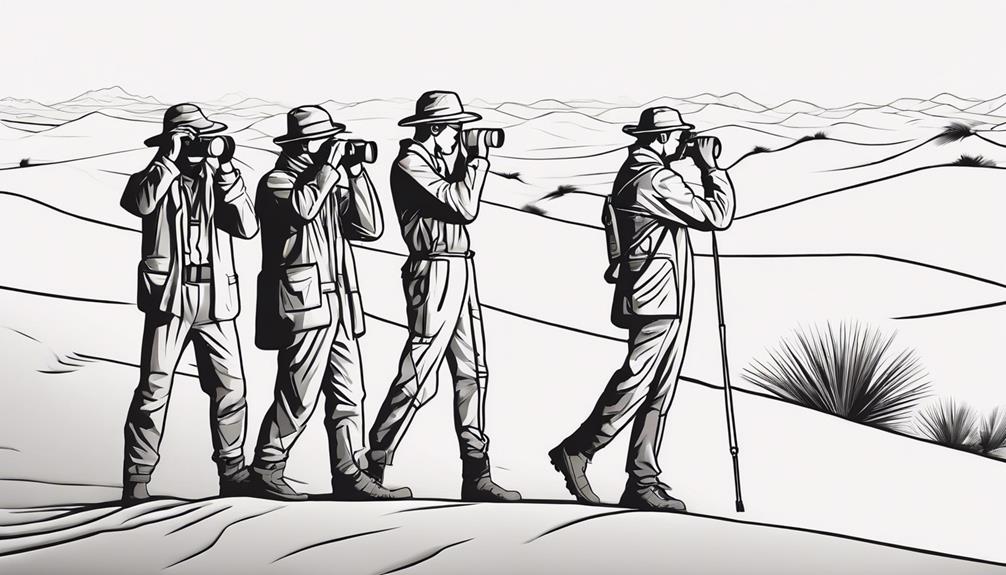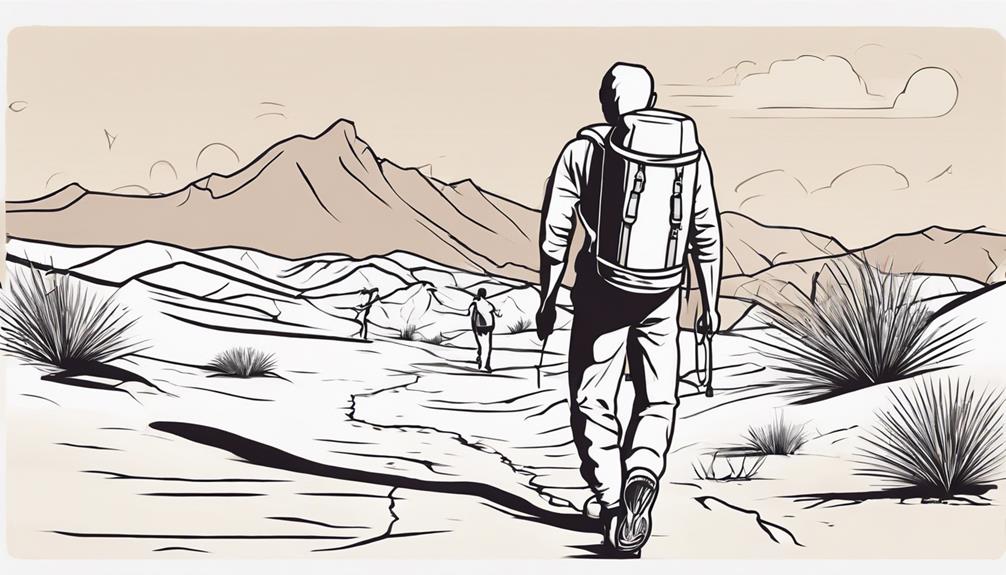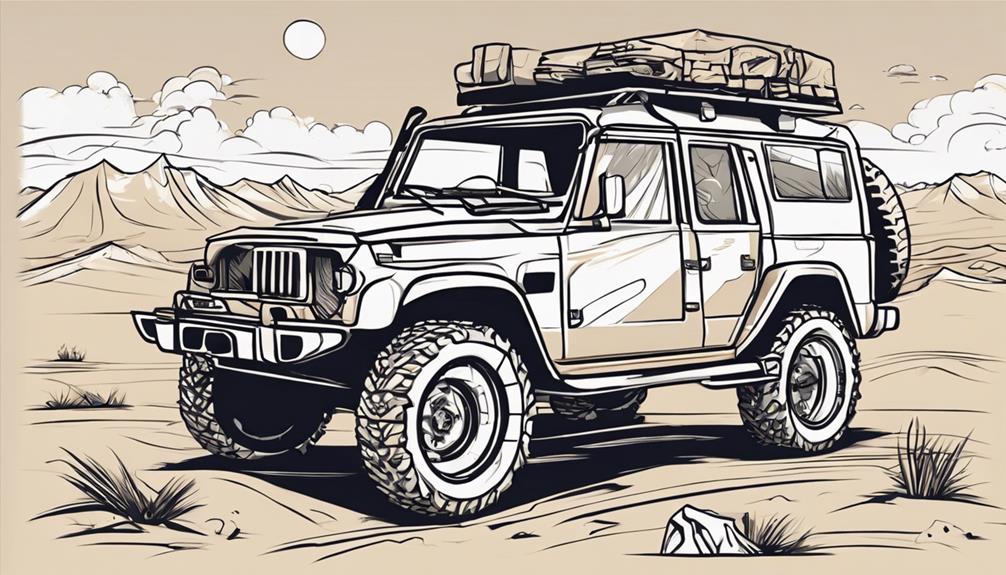Exploration of the desert, an endeavor as challenging as it is intriguing, requires a meticulous approach and a deep understanding of the harsh environment. From traditional methods like camel caravans to modern techniques utilizing advanced navigation tools and vehicles, the ways in which individuals navigate and survive in the desert are as diverse as the landscapes themselves. The desert's unforgiving nature demands respect and preparation, prompting explorers to adapt and innovate in their quest for discovery. In unraveling the mysteries hidden within the vast expanses of sand and rock, explorers are not only driven by curiosity but also by the primal urge to conquer the unknown.
Key Takeaways
- Transportation methods include camels, horses, and 4WD vehicles for desert exploration.
- Navigation tools like compasses, GPS devices, and maps aid in accurate orientation in the desert.
- Water management is crucial, utilizing purification methods and innovative techniques to ensure hydration.
- Survival gear such as GPS devices, water filtration systems, and shelter options are essential for desert adventures.
Desert Exploration Methods

Desert exploration methods encompass a variety of transportation modes, navigation tools, and survival strategies utilized by adventurers to navigate and study these arid landscapes. When venturing into the desert, explorers often rely on camels, horses, or 4WD vehicles for transportation due to the challenging terrain. Water sources such as wells, oases, and rivers are critical considerations for expeditions, as access to water is essential for survival in these harsh environments. Additionally, explorers must be well-prepared to endure extreme temperatures by carrying supplies, camping gear, and protective clothing.
Scientific research is also a significant aspect of desert exploration, with many expeditions focusing on studying the flora, fauna, geology, and climate of these regions. To navigate the vast expanses of the desert, explorers utilize a combination of GPS technology, satellite imagery, and traditional navigation techniques. By employing a mix of transportation methods, knowledge of water sources, preparation for extreme conditions, and scientific research initiatives, adventurers can effectively explore and unravel the mysteries of the desert landscape.
Navigation Tools for Desert Exploration
Explorers embarking on journeys through arid landscapes employ a range of sophisticated navigation tools to overcome the challenges posed by the harsh desert terrain. Desert explorers heavily rely on instruments such as compasses, GPS devices, and maps to navigate accurately through the vast and often featureless desert expanses. In the absence of prominent landmarks, navigation by the sun and stars serves as a traditional yet effective method to determine direction and time during desert exploration.
Moreover, modern technologies play a crucial role in desert navigation. Satellite imagery provides valuable insights into the topography, helping expeditions plan routes and anticipate obstacles in remote desert regions. Drones are also utilized to survey terrain from above, offering a strategic advantage in navigation and exploration.
To ensure safety during desert expeditions, many explorers carry survival kits containing signaling devices, emergency beacons, and tools for water purification. Advanced communication tools like satellite phones and GPS trackers are essential for maintaining contact with the outside world and tracking the progress of the expedition in the vast desert wilderness.
Importance of Water in Desert Exploration

Water, being a critical element for sustaining life, holds paramount importance in the realm of desert exploration. In the arid desert environment, where temperatures soar and water sources are scarce, maintaining proper hydration is essential for survival. Desert explorers must consume around 2-4 liters of water per day to prevent dehydration, a condition that can quickly become life-threatening in such extreme conditions. To ensure the safety of the water they consume, desert explorers often rely on water purification tablets or filters to make any available water sources safe to drink. Additionally, carrying camel packs or canteens is common practice to store an adequate supply of water during desert expeditions. Some explorers also employ innovative techniques like dew collection or solar stills to extract water from the environment when traditional water sources are not available. Water conservation practices, such as minimizing sweat loss and rationing water intake, play a crucial role in the success of desert exploration expeditions.
Survival Gear for Desert Adventures
In the challenging landscape of the desert, equipping oneself with essential survival gear is paramount for ensuring safety and preparedness during adventurous expeditions. A reliable GPS device is a crucial tool for desert exploration, aiding in accurate navigation through vast and featureless terrains. Additionally, a high-quality water filtration system is essential to purify scarce water sources in deserts, mitigating the risk of dehydration.
When embarking on desert adventures, lightweight and durable shelter options like compact tents or reflective emergency blankets provide vital protection from extreme desert conditions. Carrying a multifunctional tool such as a Swiss Army knife proves invaluable for various tasks like cutting, opening cans, and gear repairs in the desert environment. Furthermore, packing high-energy, non-perishable foods like nuts, dried fruits, and energy bars is essential for maintaining energy levels and proper nutrition amidst the harsh desert conditions. Ensuring the presence of these key survival gear items significantly enhances the safety and comfort of desert explorers.
Desert Exploration Vehicles

Desert exploration vehicles are specially designed 4WD vehicles equipped with off-road capabilities and rugged tires, essential for navigating the challenging terrain of arid landscapes. Among the popular choices for desert exploration are the Land Rover Defenders, Toyota Land Cruisers, and Jeep Wranglers, known for their reliability and durability in harsh conditions. These vehicles are often modified to carry extra fuel, water, and supplies, enabling extended expeditions into remote desert regions. To ensure safety, desert exploration vehicles are equipped with GPS navigation systems, communication devices, and emergency equipment. For those embarking on longer journeys, expedition trucks like the Mercedes Unimog and EarthRoamer XV-LTS offer comfortable living quarters, making extended desert expeditions more feasible. The combination of rugged construction, off-road capabilities, and specialized equipment makes desert exploration vehicles indispensable tools for adventurers seeking to traverse the challenging and unforgiving landscapes of the desert.
Frequently Asked Questions
How Do People in the Desert Travel?
In the desert, people travel using various means, including camel caravans, off-road vehicles, and trekking on foot. Navigating through sand dunes and accessing remote areas often requires a combination of these methods. Nomadic tribes utilize traditional knowledge and landmarks, while modern technology such as GPS enhances navigation and safety. Camping in desert oases provides shelter and rest during expeditions. The diverse modes of travel in desert exploration cater to different terrains efficiently.
How Do People Navigate the Desert?
Desert navigation involves utilizing a variety of techniques such as orienteering methods, map reading, GPS usage, and compass navigation. Survival skills in the desert include tracking wind patterns, sand drifts, animal tracks, and vegetation to stay on course. Trekking tips often involve following natural features like sand dunes and mountain ranges. By combining these skills, desert explorers can effectively navigate the vast and challenging landscapes of the desert.
How Do People Travel in the Sahara Desert?
Traveling in the Sahara Desert encompasses various methods, including desert vehicles, camel caravans, trekking, and camping. The vast expanse of sand dunes requires specialized navigation techniques, often relying on desert oases for sustenance. Explorers encounter unique desert wildlife, adapting to the harsh environment. Understanding the challenges of desert travel is essential for successful exploration and safe passage through this arid landscape. How can one navigate such a diverse and challenging terrain?
How Do Humans Live in Desert?
Desert dwellings are adapted to extreme conditions, often featuring thick walls for insulation. Survival essentials include traditional water collection methods like rooftop systems and underground storage tanks. Clothing choices prioritize protection from the sun and heat. Food options vary but may include drought-resistant crops and livestock. Community support is crucial for sharing resources and knowledge. Shelter building techniques are designed for temperature regulation and protection from harsh weather conditions.
Conclusion
In conclusion, the desert remains an enigmatic and challenging environment that has attracted explorers throughout history. Like a vast, untamed wilderness waiting to be conquered, the desert offers a unique blend of mystery, beauty, and hardship that continues to inspire individuals to push the boundaries of human exploration and endurance. As adventurers navigate the harsh landscapes and unpredictable conditions, they unlock the secrets of the desert, revealing its hidden treasures and timeless allure.
